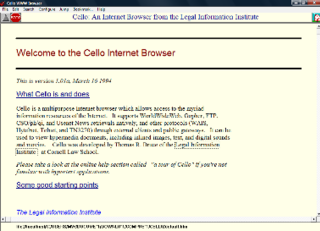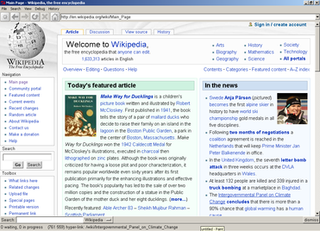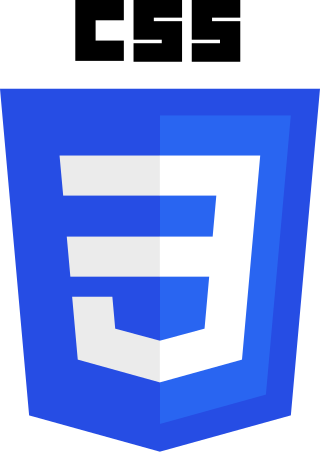
HyperText Markup Language (HTML) is the standard markup language for documents designed to be displayed in a web browser. It defines the content and structure of web content. It is often assisted by technologies such as Cascading Style Sheets (CSS) and scripting languages such as JavaScript.
Scalable Vector Graphics (SVG) is an XML-based vector image format for defining two-dimensional graphics, having support for interactivity and animation. The SVG specification is an open standard developed by the World Wide Web Consortium since 1999.

The World Wide Web is an information system that enables content sharing over the Internet through user-friendly ways meant to appeal to users beyond IT specialists and hobbyists. It allows documents and other web resources to be accessed over the Internet according to specific rules of the Hypertext Transfer Protocol (HTTP).

Curl is a reflective object-oriented programming language for interactive web applications, whose goal is to provide a smoother transition between content formatting and computer programming. It makes it possible to embed complex objects in simple documents without needing to switch between programming languages or development platforms. The Curl implementation initially consisted of an interpreter only; a compiler was added later.

NCSA Mosaic was among the first widely available web browsers, instrumental in popularizing the World Wide Web and the general Internet by integrating multimedia such as text and graphics. Mosaic was the first browser to display images inline with text.

Cello is an early, discontinued graphical web browser for Windows 3.1; it was developed by Thomas R. Bruce of the Legal Information Institute at Cornell Law School. It was released as shareware in 1993. While other browsers ran on various Unix machines, Cello was the first web browser for Microsoft Windows, using the winsock system to access the Internet. In addition to the basic Windows, Cello worked on Windows NT 3.5 and with small modifications on OS/2.
An HTML editor is a program used for editing HTML, the markup of a web page. Although the HTML markup in a web page can be controlled with any text editor, specialized HTML editors can offer convenience, added functionality, and organisation. For example, many HTML editors handle not only HTML, but also related technologies such as CSS, XML and JavaScript or ECMAScript. In some cases they also manage communication with remote web servers via FTP and WebDAV, and version control systems such as Subversion or Git. Many word processing, graphic design and page layout programs that are not dedicated to web design, such as Microsoft Word or Quark XPress, also have the ability to function as HTML editors.

WorldWideWeb is the first web browser and web page editor. It was discontinued in 1994. It was the first WYSIWYG HTML editor.

Amaya is a discontinued free and open source WYSIWYG web authoring tool with browsing abilities.

The Line Mode Browser is the second web browser ever created. The browser was the first demonstrated to be portable to several different operating systems. Operated from a simple command-line interface, it could be widely used on many computers and computer terminals throughout the Internet. The browser was developed starting in 1990, and then supported by the World Wide Web Consortium (W3C) as an example and test application for the libwww library.

AOLpress is a discontinued HTML editor that was available from America Online (AOL). It was originally developed as NaviPress by the company NaviSoft before being bought by AOL. It was discontinued in 2000. However, the last version (2.0) may still be found on some Web sites for downloading.

Libwww is an early World Wide Web software library providing core functions for web browsers, implementing HTML, HTTP, and other technologies. Tim Berners-Lee, at the European Organization for Nuclear Research (CERN), released libwww in late 1992, comprising reusable code from the first browsers.

HTML5 is a markup language used for structuring and presenting hypertext documents on the World Wide Web. It was the fifth and final major HTML version that is now a retired World Wide Web Consortium (W3C) recommendation. The current specification is known as the HTML Living Standard. It is maintained by the Web Hypertext Application Technology Working Group (WHATWG), a consortium of the major browser vendors.

Tkhtml is a discontinued open-source browser engine written in C using the Tk widget toolkit. It was used primarily by the Html Viewer 3 (Hv3) minimalist web browser.
Extensible HyperText Markup Language (XHTML) is part of the family of XML markup languages which mirrors or extends versions of the widely used HyperText Markup Language (HTML), the language in which Web pages are formulated.

Cascading Style Sheets (CSS) is a style sheet language used for specifying the presentation and styling of a document written in a markup language such as HTML or XML. CSS is a cornerstone technology of the World Wide Web, alongside HTML and JavaScript.

The Arena browser was one of the first web browsers for Unix. Originally begun by Dave Raggett in 1993, development continued at CERN and the World Wide Web Consortium (W3C) and subsequently by Yggdrasil Computing. Arena was used in testing the implementations for HTML version 3.0, Cascading Style Sheets (CSS), Portable Network Graphics (PNG), and libwww. Arena was widely used and popular at the beginning of the World Wide Web.

The First International Conference on the World-Wide Web was the first-ever conference about the World Wide Web, and the first meeting of what became the International World Wide Web Conference. It was held on May 25 to 27, 1994 in Geneva, Switzerland. The conference had 380 participants, who were accepted out of 800 applicants. It has been referred to as the "Woodstock of the Web".
The Web platform is a collection of technologies developed as open standards by the World Wide Web Consortium and other standardization bodies such as the Web Hypertext Application Technology Working Group, the Unicode Consortium, the Internet Engineering Task Force, and Ecma International. It is the umbrella term introduced by the World Wide Web Consortium, and in 2011 it was defined as "a platform for innovation, consolidation and cost efficiencies" by W3C CEO Jeff Jaffe. Being built on The evergreen Web has allowed for the addition of new capabilities while addressing security and privacy risks. Additionally, developers are enabled to build interoperable content on a cohesive platform.
Agora was a World Wide Web email browser and was a proof of concept to help people to use the full internet. Agora was an email-based web browser designed for non-graphic terminals and to help people without full access to the internet such as in developing countries or without a permanent internet connection. Similar to W3Gate, Agora was a server application designed to fetch HTML documents through e-mail rather than http.














